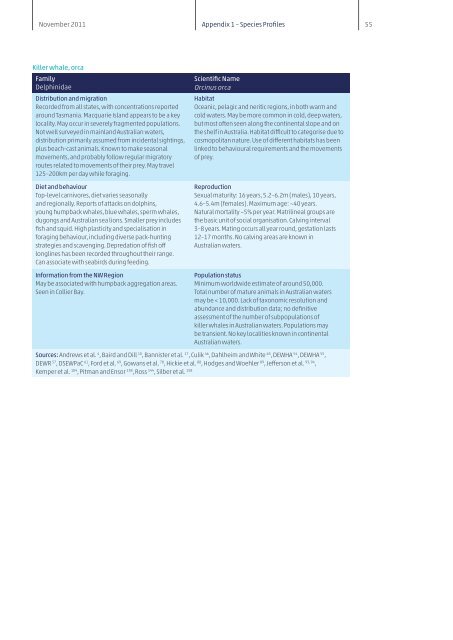Australia's last great whale haven.pdf - Ningaloo Atlas
Australia's last great whale haven.pdf - Ningaloo Atlas
Australia's last great whale haven.pdf - Ningaloo Atlas
- TAGS
- whale
- ningaloo
- atlas
- www.ifaw.org
You also want an ePaper? Increase the reach of your titles
YUMPU automatically turns print PDFs into web optimized ePapers that Google loves.
November 2011 Appendix 1 – Species Profiles<br />
55<br />
Killer <strong>whale</strong>, orca<br />
Family<br />
Delphinidae<br />
Distribution and migration<br />
Recorded from all states, with concentrations reported<br />
around Tasmania. Macquarie Island appears to be a key<br />
locality. May occur in severely fragmented populations.<br />
Not well surveyed in mainland Australian waters,<br />
distribution primarily assumed from incidental sightings,<br />
plus beach-cast animals. Known to make seasonal<br />
movements, and probably follow regular migratory<br />
routes related to movements of their prey. May travel<br />
125–200km per day while foraging.<br />
Diet and behaviour<br />
Top-level carnivores, diet varies seasonally<br />
and regionally. Reports of attacks on dolphins,<br />
young humpback <strong>whale</strong>s, blue <strong>whale</strong>s, sperm <strong>whale</strong>s,<br />
dugongs and Australian sea lions. Smaller prey includes<br />
fish and squid. High p<strong>last</strong>icity and specialisation in<br />
foraging behaviour, including diverse pack-hunting<br />
strategies and scavenging. Depredation of fish off<br />
longlines has been recorded throughout their range.<br />
Can associate with seabirds during feeding.<br />
Information from the NW Region<br />
May be associated with humpback aggregation areas.<br />
Seen in Collier Bay.<br />
Scientific Name<br />
Orcinus orca<br />
Habitat<br />
Oceanic, pelagic and neritic regions, in both warm and<br />
cold waters. May be more common in cold, deep waters,<br />
but most often seen along the continental slope and on<br />
the shelf in Australia. Habitat difficult to categorise due to<br />
cosmopolitan nature. Use of different habitats has been<br />
linked to behavioural requirements and the movements<br />
of prey.<br />
Reproduction<br />
Sexual maturity: 16 years, 5.2–6.2m (males), 10 years,<br />
4.6–5.4m (females). Maximum age: ~40 years.<br />
Natural mortality ~5% per year. Matrilineal groups are<br />
the basic unit of social organisation. Calving interval<br />
3–8 years. Mating occurs all year round, gestation <strong>last</strong>s<br />
12–17 months. No calving areas are known in<br />
Australian waters.<br />
Population status<br />
Minimum worldwide estimate of around 50,000.<br />
Total number of mature animals in Australian waters<br />
may be < 10,000. Lack of taxonomic resolution and<br />
abundance and distribution data; no definitive<br />
assessment of the number of subpopulations of<br />
killer <strong>whale</strong>s in Australian waters. Populations may<br />
be transient. No key localities known in continental<br />
Australian waters.<br />
Sources: Andrews et al. 4 , Baird and Dill 10 , Bannister et al. 17 , Culik 46 , Dahlheim and White 48 , DEWHA 54 , DEWHA 55 ,<br />
DEWR 57 , DSEWPaC 61 , Ford et al. 69 , Gowans et al. 78 , Hickie et al. 88 , Hodges and Woehler 89 , Jefferson et al. 93, 94 ,<br />
Kemper et al. 104 , Pitman and Ensor 138 , Ross 144 , Silber et al. 158

















